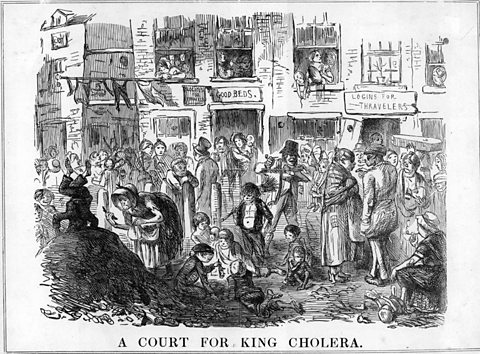Video - Disease
Disease. That word gives me the shivers. I think of being unwell, people coughing and spreading germs. Urgh!
But imagine living in a time where disease was rife and medicine was practically non-existent, hygiene was unheard of and living conditions were poor. Grim.
Well, thatâs exactly what people in Britain had to endure in the 14th century in towns like Kidwelly and Caldicot. During this time, which is also known as the medieval period, people didnât really have any idea about germs.
Letâs take a look at one of the most infamous infectious diseases, the Black Death. Named after the incredibly unpleasant black buboes that would appear under peopleâs arms and other areas of the body. Other symptoms would include fever, sweating, being sick, and some severe breathing problems too.
It was horrible and some historians believe it killed nearly 50% of the British population. At the time, people thought it was an act of God, a punishment for their sins.
People tried loads of weird tricks to try and stop themselves getting the disease, like carrying herbs around with them, dissecting a pigeon and rubbing it over their body. Some even took arsenic. Desperate times call for desperate measures I guess. But not even a dead pigeon would save the population from this harsh pandemic.
The town of Kidwelly was affected badly. Legend has it that the reason the town has the black cat as its emblem, is because it was the first creature to be seen alive after the plague.
Disease has always been a problem, and every century has seen a new illness. Among the deadliest diseases that spread over the centuries is the cholera that people suffered during the Victorian era.
The Spanish Flu was another devastating pandemic, a disease that hit the world just as the First World War was ending. Some would say it was the worst disease in history, killing up to 100 million people.
Thatâs the equivalent of combining the population of the UK and Poland today. It spread like wildfire, from the war zones in Europe to some of the most rural areas in Wales.
But why was it was commonly referred to as the Spanish Flu? Because Spain wasnât involved in the war, there was no wartime censorship, so the pandemic got more attention from the press when it moved from France to Spain in November 1918.
A little unfair on the Spaniards, labelling the deadliest disease as a Spanish one.
Thankfully, we have learnt a lot since then and there have been huge medical advancements and pioneering individuals have been able to develop all sorts of cures.
The Black Death
The Black Death pandemicAn outbreak of infectious disease that occurs over a wide geographical area that affects a large number of people., or the âgreat mortalityâ, happened during the 14th century and wasnât fully eradicateTo destroy or put an end to something. until the end of the Middle Ages. The main wave of the Black Death was between 1349 and 1350 when one in three people were killed. There was a second wave between 1360-62.
The plague spread across Europe from Asia and it is thought that the illness killed around 75 million people. The first record of deaths from the plague in Wales was in Carmarthen, an important port at the time. Similarly, the plague also had an early impact on Abergavenny, Caldicot, Pembroke, Haverfordwest and Holywell.
Symptoms of the plague
Symptoms included:
- sneezing
- blisters
- swelling of the armpits
- skin becoming pale and smelly
- skin turning black
There were two types of plague, the bubonic plagueA plague spread by fleas. carried by fleas and the pneumonic plagueA plague transmitted by breathing. transmitted by breathing. There was much superstitionAn irrational belief in supernatural influences. in the Middle Ages regarding the causes of the plague, with one of the main beliefs being that it was punishment from God.
Effects of the plague
The plague impacted greatly on agriculture with an increasing shortage of workers leading to much empty terrain. Some villages and towns disappeared completely, eg Llanllwch, near Carmarthen, and Radyr.
Many people who rented land left Wales for England following an increase in taxes. This meant that many lordsRich people who owned land. lost money because they received less income from rents.
A lot of food-growing land was converted to rear animals as fewer workers were needed.
The consequences of the plague led to insurrection in France in 1358 and in England in 1381. It is also believed that the impacts of the Black Death were among the reasons for Owain GlyndĆ”râs insurrection in 1400.
Cholera
Cholera is an illness caused by a lack of clean drinking water. overpopulationToo many people living in one place. and a lack of ventilation in many houses also led to the illness spreading in Victorian times.
Cholera in Wales
The first large cholera epidemicAn infectious disease which spreads rapidly to a large number of people in a short period of time. to hit south Wales happened in 1832. The areas of Rhymney, Nant-y-glo and Cefn Golau were badly affected and 203 people died in Tredegar alone.
In 1849, the illness badly affected the town of Merthyr. It was a year of drought that led to a shortage of clean water. A four-year-old girl was the first to die of cholera in the town in May 1849. By the summer months, 36 people were dying every day on average. There were 1,682 deaths from cholera in Merthyr in that year.

The disease affected Cardiff in the same year, killing 382 people. Many of Cardiffâs population received their drinking water from the Glamorgan Canal that was polluted by rubbish and sewage.
Thomas Webster Rammell, an inspector leading the Health Boardâs work, was employed to write a report in 1849-50. In his report, he argued that overpopulation and a lack of drinking water were the main causes of the cases in Cardiff. His report referred to:
- a house in Stanley Street where 54 people lived in just four rooms â the children had no beds and had to sleep in boxes with other children
- worms in the water of a well in Mary Ann Street
- the Waterloo Buildings, where 11 or 12 households shared just two toilets
Despite this report on Cardiff, cholera remained a problem until the 1880s. A hospital was established on Flat Holm Island specifically for cholera patients. On 8 September 1884, three sailors from Marseilles were taken to the island as they had cholera.
Spanish flu
The Spanish flu epidemic occurred between 1918 and 1919, and despite its name, the first cases were recorded in the United States of America followed by France, Germany and Britain. There are differing estimates of how many people died, with figures ranging from 17 to 50 million over four different waves of the illness.
The pandemic started at the end of the First World War and news of the flu was kept quiet to avoid affecting peopleâs spirits after the war. Newspapers in Spain, a country not involved in the war, were the first to report the flu, hence the name of the illness.
Spanish flu in Wales
The flu had a greater impact on Wales during the second wave. 144 deaths were recorded in the Rhondda in July 1918. The industrial areas of south Wales suffered greatly from the disease as the population lived close together. Rural areas also suffered badly. The highest death rate for the epidemic period in Wales was in the old county of Caernarfonshire.
The Cambrian Journal newspaper announced 349 deaths in Carmarthenshire in January 1919, showing that all areas of Wales felt the impact of the Spanish flu. It is believed that around 11,400 people died of the flu in Wales.
What is the situation of diseases today?
The Covid-19 pandemic has shown that there have been considerable medical advances such as vaccines to deal with illnesses. As well as this, effective planning of homes and hygiene standards have prevented the re-emergence of many illnesses, such as cholera. Cholera is still seen in some parts of the world such as Africa, south-east Asia and Haiti.
Although research and medical advances have substantially improved the treatment of diseases, there are similarities between the impact of the Covid-19 pandemic and that of historical diseases, eg a greater number of older people killed, the lack of a vaccine to prevent the disease initially and a negative impact on the economy.
Quiz - Disease
More on Revolution
Find out more by working through a topic
- count3 of 3

- count1 of 3
